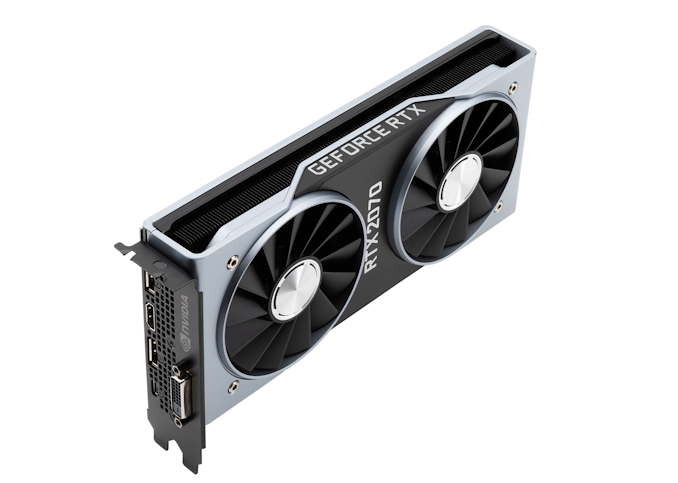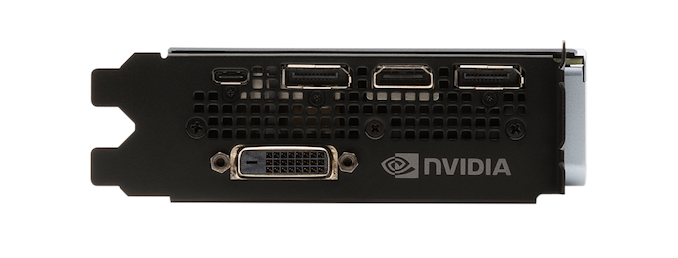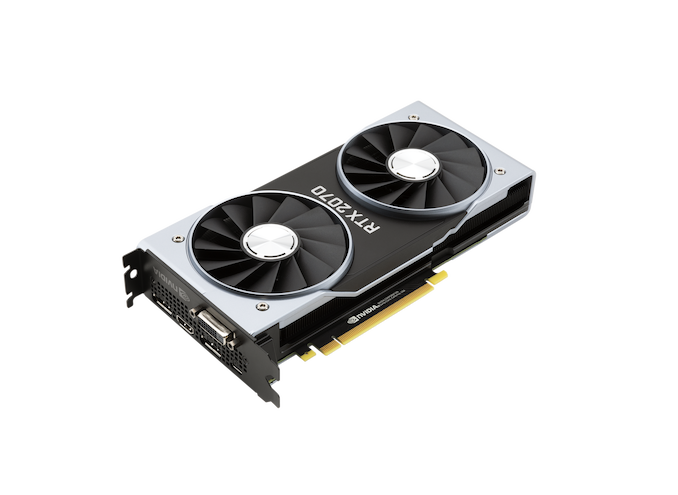The NVIDIA GeForce RTX 2070 Founders Edition Review: Mid-Range Turing, High-End Price
by Nate Oh on October 16, 2018 9:00 AM ESTMeet The GeForce RTX 2070 Founders Edition Card
Touching quickly on the card itself, there's little we haven't already seen with the RTX 2080 Ti and 2080 Founders Editions. The biggest change is, of course, a new open air cooler design. Along with the Founders Edition specification changes of +10W TDP and +90 MHz boost clockspeed, the cards might be considered 'reference' in that they remain a first-party video card sold direct by NVIDIA, but strictly-speaking they are not because they no longer carry reference specifications.
Wrapped in the flattened industrial design introduced by the other RTX cards, the RTX 2070 Founders Edition looks essentially the same, save a few exceptions. The single 8-pin power connector is at the front of the card, while the NVLink SLI connectors are absent as the RTX 2070 does not support SLI. Internally, the dual 13-blade fans accompany a vapor chamber, while a 6-phase system provides the power for the 185W TDP RTX 2070 Founders Edition.
So while the single 8-pin configuration, suitable for up to 225W total draw, has remained the same from the GTX 1070, the TDP has not. The RTX 2070 Founders Edition brings 185W, with reference specification at 175W, compared to the 150W GTX 1070 and 145W GTX 970, following the trend of the 2080 Ti and 2080 pushing up the watts.
As for I/O, there is one difference between the 2070 and its older siblings. The RTX 2070 Founders Edition drops the isolated DisplayPort for a DVI port, matching the GTX 1070's outputs. This is in addition to DisplayPort 1.4 and DSC support, the latter of which is part of the DP1.4 spec, as well as the VR-centric USB-C VirtualLink port, which also carries an associated 30W not included in the overall TDP. While the past few years have seen DVI excised from the top-end cards, it's more of a matter of practicality for mid-range cards (inasmuch as $500 is a midrange price) that are often paired with budget DVI monitors, particularly as a drop-in upgrade for an aging video card.
As mentioned in the RTX 2080 Ti and 2080 launch article, something to note is the potential impact on OEM sales with this reference design change. The RTX 2070 also arrives as an open air design and so can no longer guarantee self-cooling independent of chassis airflow. In addition to the price and lower volume nature of these GPU parts, these aspects make the RTX reference cards less suitable for large OEMs.














121 Comments
View All Comments
Vayra - Monday, October 22, 2018 - link
In the same vein you could say 'why get so hung up on a name to defend its a same tier card'Price matters because if perf/dollar doesn't improve there is no reason for any *buyer* to see it as a direct replacement.
Midwayman - Tuesday, October 16, 2018 - link
Why would you say that the 1080 is the card to beat and then use a garbage FE version as the benchmark comparison. Every 1080 card you're going to buy today is substantially faster than that FE version.Dr. Swag - Tuesday, October 16, 2018 - link
Because that's what they have... Plus they downclocked the founders 2070 to reference speeds too so it's not like it's that big of a deal.Midwayman - Tuesday, October 16, 2018 - link
They have tested numerous non-FE 1080 cards. The issue is that its a comparison nobody will be making when buying a 1080. It makes the 2070 look way better in the graphs than it should. If they feel the need to include a FE model for reference, fine. But they should have included a version with the faster ram and a typical factory OC since that is what is most often for sale right now. Particularly in light of the price point of the 2070.Yojimbo - Tuesday, October 16, 2018 - link
How does it make it look much better than it should when they downclocked the founder's edition to a clock below what the 3rd party 2070 cards which are comparable to the 1080s you want to use will be using.And I don't think you can use the price point of the 2070 FE or the base 2070 as a justification to include factory overclocked cards from 3rd party board partners. There are other reasons for the price differential besides price/performance in current games. And since there is a price premium for NVIDIA FE cards you're going to end up with a price comparison problem anyway.
They tested numerous non-FE 1080 cards and when they are available I'm sure they will test numerous non-FE 2070 cards. When that happens I am sure they will make the comparisons among those two sets of cards, since there will no longer be the FE/non-FE problem.
Yojimbo - Tuesday, October 16, 2018 - link
It's a difficult situation because there seems to be a dollar value to the founder's edition beyond the performance, and the reviewed card is a founder's edition.Ryan Smith - Tuesday, October 16, 2018 - link
Our editorial policy long has been (and remains) that we'll always compare products stock to stock. That means comparing a reference clocked 1070 to a reference clocked 2070, etc. This is so that we never overstate the performance of a product; as we use the reference specs, anything you buy will be as fast as our card, if not faster. As we can only loo at a finite number of cards, it continues to be the fairest and most consistent way to test cards.Plus we got a earful (rightfully) whenever we've deviated from this. You guys have made it very clear that you don't like seeing factory overclocked cards treated as any kind of baseline in a launch article.
Exodite - Tuesday, October 16, 2018 - link
Thank you Ryan!I, for one, appreciate this approach and I'm very glad to see Anandtech sticking to it.
Eletriarnation - Tuesday, October 16, 2018 - link
Pretty sure there's a mistake in the chart on the front page that puts the transistor count of the 2070 as >2x the 2080.cwolf78 - Tuesday, October 16, 2018 - link
My first PC was a Tandy 1000 RL with an Intel 8086 CPU. The first PC I ever built was a 486SX/25 and I've been a PC gamer ever since. For the first time since, well, ever, I'm seriously considering just forgoing PC gaming in the short-term. Between the ridiculous pricing of GPU's and RAM, I just don't see how this can be a hobby for the vast majority of people anymore. It's nice that you can get a lot of bang for your CPU buck these days, that doesn't even begin to make up for how much you have to bend over for the rest of it. I think I'll be getting a PS5 and call it a day and use my current PC with its OC GTX 970 for any PC exclusives I may want to play. I just can't justify spending these kind of prices. Nvidia is going to kill PC gaming for a lot of people. I'm not sure what their strategy is except to bend people over for as long and hard as they can and only then start dropping prices one sales start taking a hit. Well, sorry, Nvidia. You need to find someone else to take advantage of.